suspension JEEP GRAND CHEROKEE 2004 WK / 3.G Owners Manual
[x] Cancel search | Manufacturer: JEEP, Model Year: 2004, Model line: GRAND CHEROKEE, Model: JEEP GRAND CHEROKEE 2004 WK / 3.GPages: 344, PDF Size: 6.09 MB
Page 202 of 344
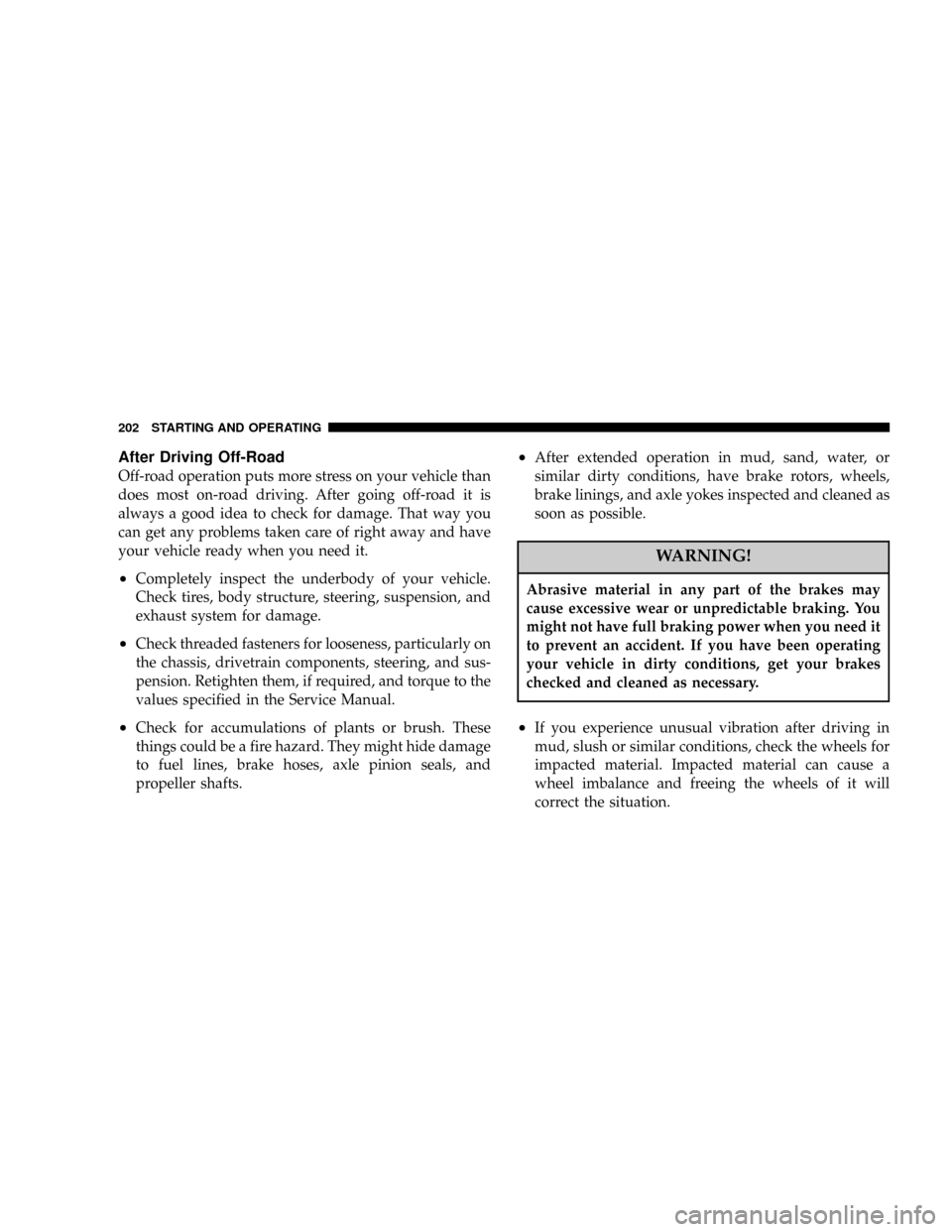
After Driving Off-Road
Off-road operation puts more stress on your vehicle than
does most on-road driving. After going off-road it is
always a good idea to check for damage. That way you
can get any problems taken care of right away and have
your vehicle ready when you need it.
²Completely inspect the underbody of your vehicle.
Check tires, body structure, steering, suspension, and
exhaust system for damage.
²Check threaded fasteners for looseness, particularly on
the chassis, drivetrain components, steering, and sus-
pension. Retighten them, if required, and torque to the
values specified in the Service Manual.
²Check for accumulations of plants or brush. These
things could be a fire hazard. They might hide damage
to fuel lines, brake hoses, axle pinion seals, and
propeller shafts.
²After extended operation in mud, sand, water, or
similar dirty conditions, have brake rotors, wheels,
brake linings, and axle yokes inspected and cleaned as
soon as possible.
WARNING!
Abrasive material in any part of the brakes may
cause excessive wear or unpredictable braking. You
might not have full braking power when you need it
to prevent an accident. If you have been operating
your vehicle in dirty conditions, get your brakes
checked and cleaned as necessary.
²If you experience unusual vibration after driving in
mud, slush or similar conditions, check the wheels for
impacted material. Impacted material can cause a
wheel imbalance and freeing the wheels of it will
correct the situation.
202 STARTING AND OPERATING
Page 216 of 344
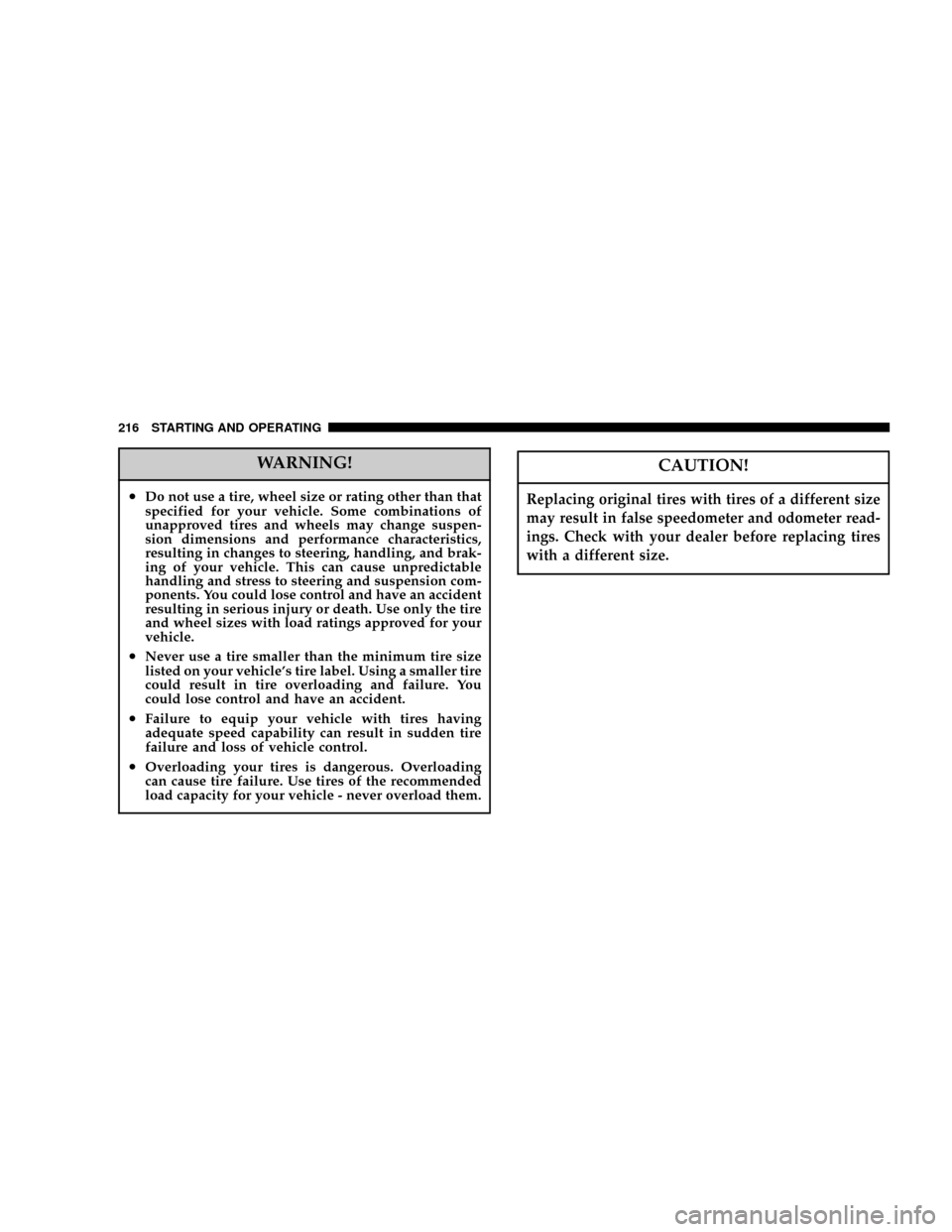
WARNING!
²Do not use a tire, wheel size or rating other than that
specified for your vehicle. Some combinations of
unapproved tires and wheels may change suspen-
sion dimensions and performance characteristics,
resulting in changes to steering, handling, and brak-
ing of your vehicle. This can cause unpredictable
handling and stress to steering and suspension com-
ponents. You could lose control and have an accident
resulting in serious injury or death. Use only the tire
and wheel sizes with load ratings approved for your
vehicle.
²Never use a tire smaller than the minimum tire size
listed on your vehicle's tire label. Using a smaller tire
could result in tire overloading and failure. You
could lose control and have an accident.
²Failure to equip your vehicle with tires having
adequate speed capability can result in sudden tire
failure and loss of vehicle control.
²Overloading your tires is dangerous. Overloading
can cause tire failure. Use tires of the recommended
load capacity for your vehicle - never overload them.
CAUTION!
Replacing original tires with tires of a different size
may result in false speedometer and odometer read-
ings. Check with your dealer before replacing tires
with a different size.
216 STARTING AND OPERATING
Page 217 of 344
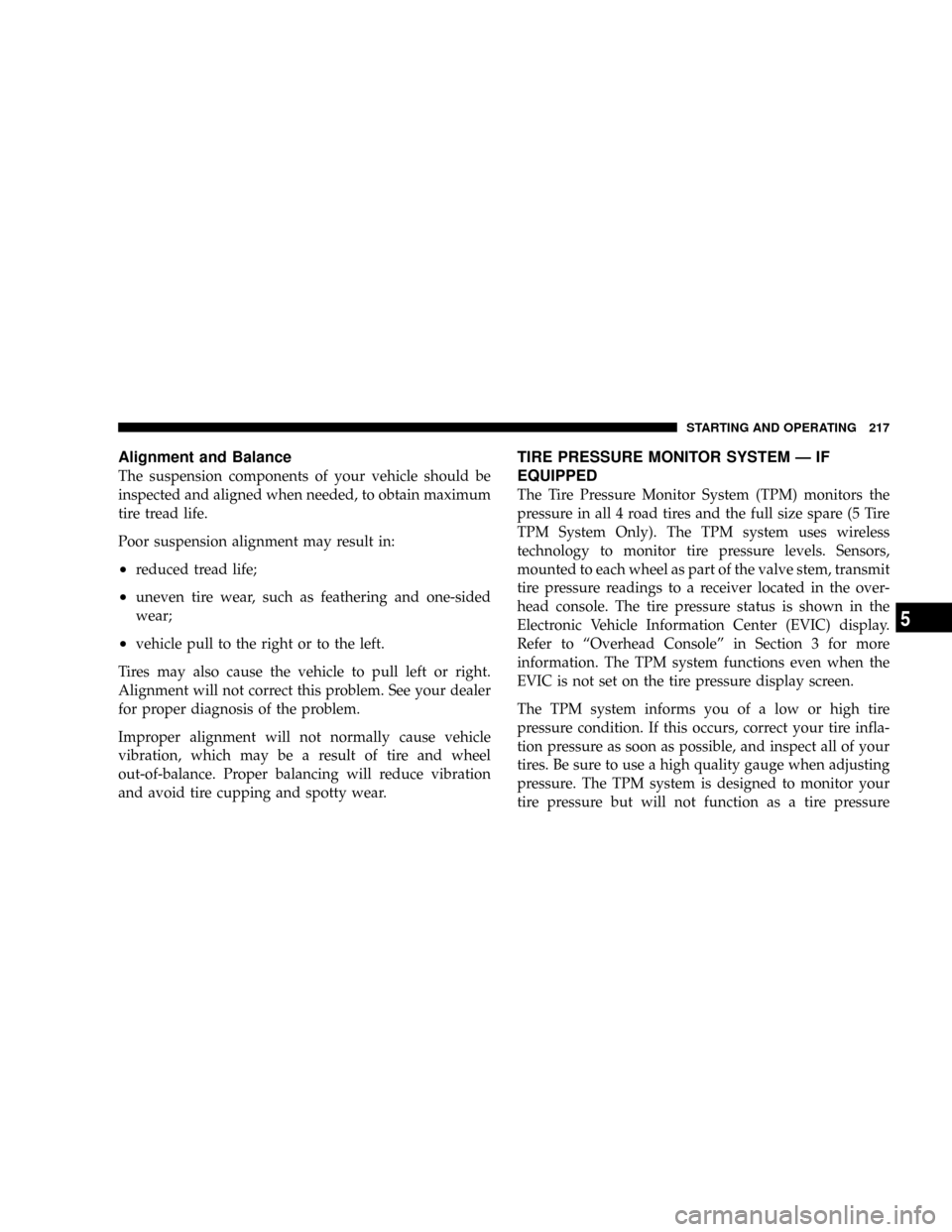
Alignment and Balance
The suspension components of your vehicle should be
inspected and aligned when needed, to obtain maximum
tire tread life.
Poor suspension alignment may result in:
²reduced tread life;
²uneven tire wear, such as feathering and one-sided
wear;
²vehicle pull to the right or to the left.
Tires may also cause the vehicle to pull left or right.
Alignment will not correct this problem. See your dealer
for proper diagnosis of the problem.
Improper alignment will not normally cause vehicle
vibration, which may be a result of tire and wheel
out-of-balance. Proper balancing will reduce vibration
and avoid tire cupping and spotty wear.
TIRE PRESSURE MONITOR SYSTEM Ð IF
EQUIPPED
The Tire Pressure Monitor System (TPM) monitors the
pressure in all 4 road tires and the full size spare (5 Tire
TPM System Only). The TPM system uses wireless
technology to monitor tire pressure levels. Sensors,
mounted to each wheel as part of the valve stem, transmit
tire pressure readings to a receiver located in the over-
head console. The tire pressure status is shown in the
Electronic Vehicle Information Center (EVIC) display.
Refer to ªOverhead Consoleº in Section 3 for more
information. The TPM system functions even when the
EVIC is not set on the tire pressure display screen.
The TPM system informs you of a low or high tire
pressure condition. If this occurs, correct your tire infla-
tion pressure as soon as possible, and inspect all of your
tires. Be sure to use a high quality gauge when adjusting
pressure. The TPM system is designed to monitor your
tire pressure but will not function as a tire pressure
STARTING AND OPERATING 217
5
Page 227 of 344
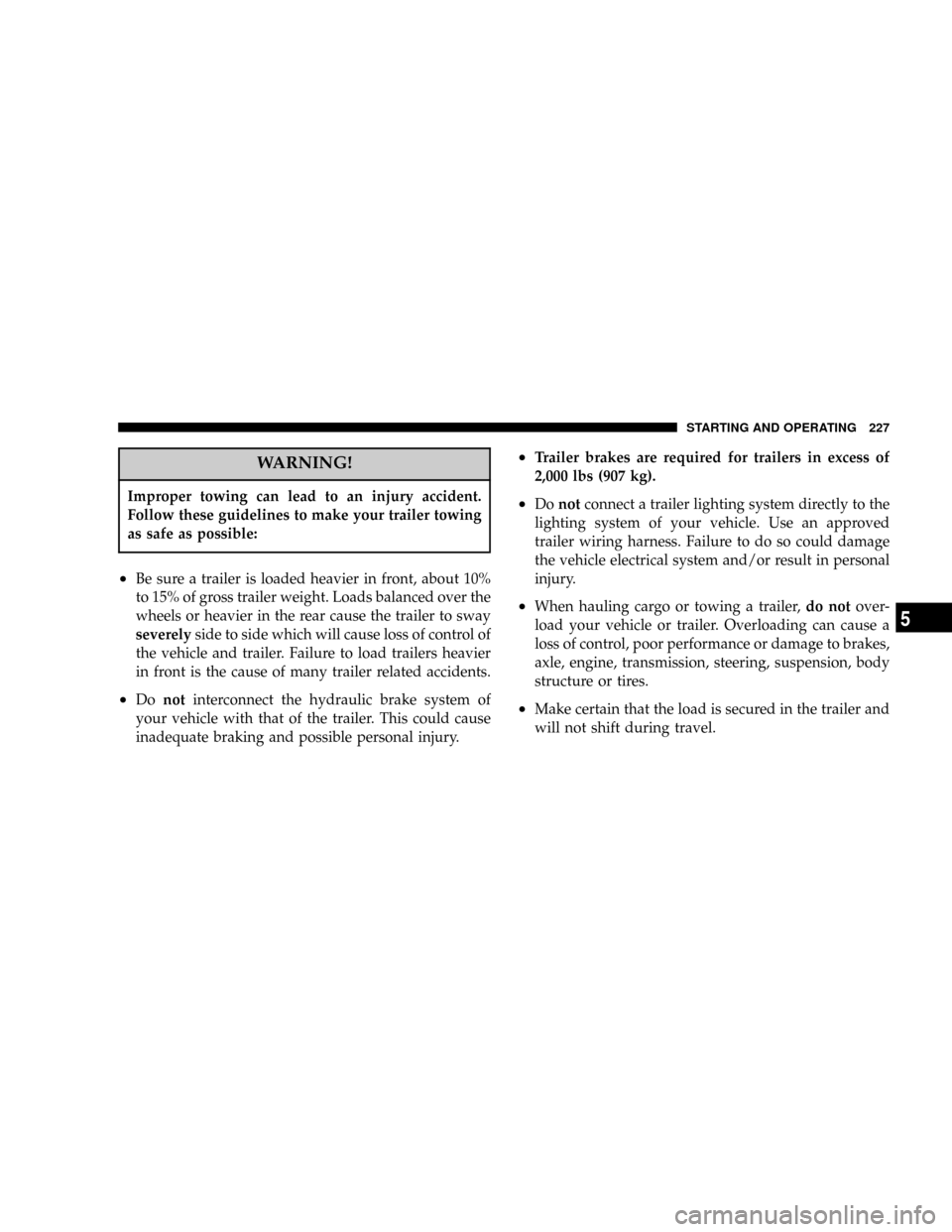
WARNING!
Improper towing can lead to an injury accident.
Follow these guidelines to make your trailer towing
as safe as possible:
²Be sure a trailer is loaded heavier in front, about 10%
to 15% of gross trailer weight. Loads balanced over the
wheels or heavier in the rear cause the trailer to sway
severelyside to side which will cause loss of control of
the vehicle and trailer. Failure to load trailers heavier
in front is the cause of many trailer related accidents.
²Donotinterconnect the hydraulic brake system of
your vehicle with that of the trailer. This could cause
inadequate braking and possible personal injury.
²Trailer brakes are required for trailers in excess of
2,000 lbs (907 kg).
²Donotconnect a trailer lighting system directly to the
lighting system of your vehicle. Use an approved
trailer wiring harness. Failure to do so could damage
the vehicle electrical system and/or result in personal
injury.
²When hauling cargo or towing a trailer,do notover-
load your vehicle or trailer. Overloading can cause a
loss of control, poor performance or damage to brakes,
axle, engine, transmission, steering, suspension, body
structure or tires.
²Make certain that the load is secured in the trailer and
will not shift during travel.
STARTING AND OPERATING 227
5
Page 285 of 344
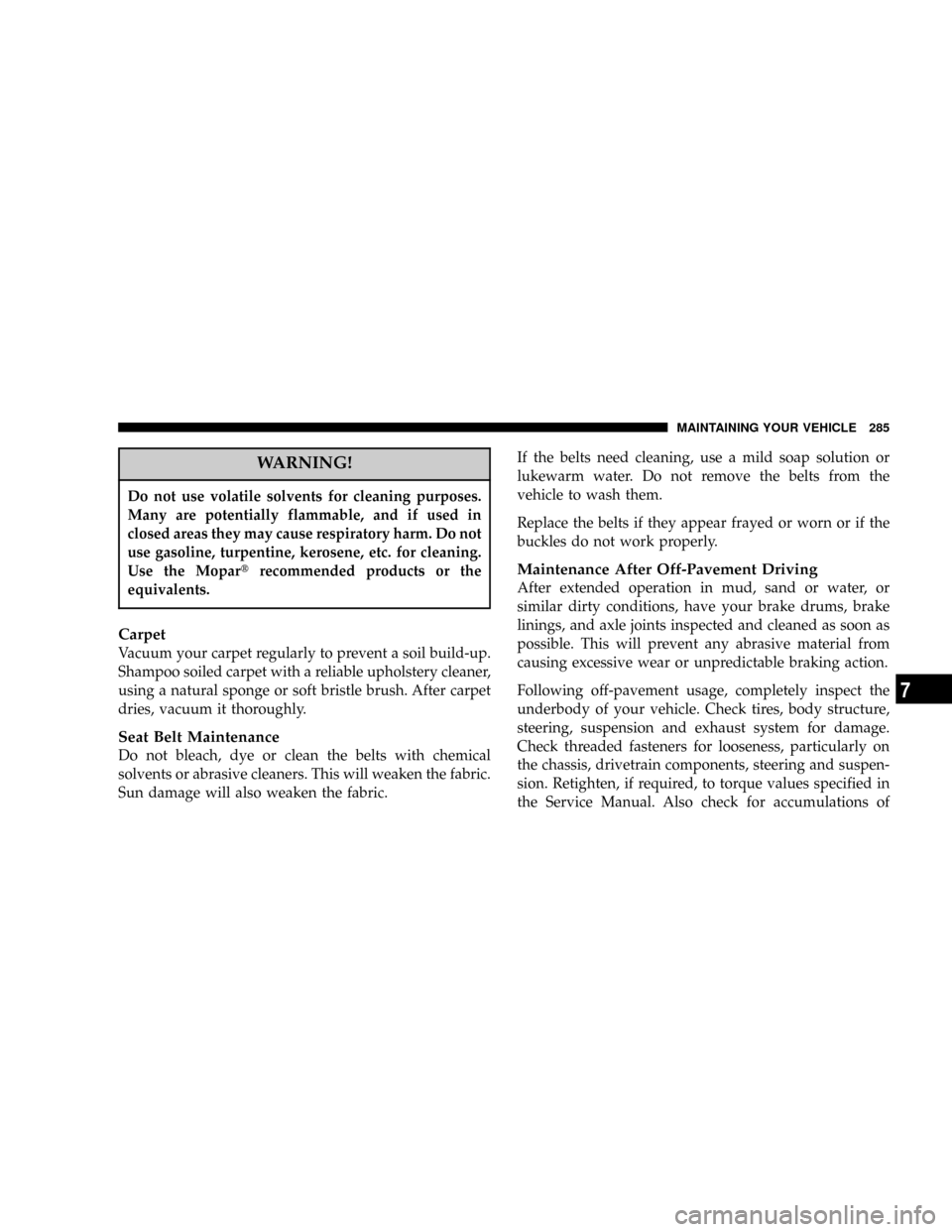
WARNING!
Do not use volatile solvents for cleaning purposes.
Many are potentially flammable, and if used in
closed areas they may cause respiratory harm. Do not
use gasoline, turpentine, kerosene, etc. for cleaning.
Use the Mopartrecommended products or the
equivalents.
Carpet
Vacuum your carpet regularly to prevent a soil build-up.
Shampoo soiled carpet with a reliable upholstery cleaner,
using a natural sponge or soft bristle brush. After carpet
dries, vacuum it thoroughly.
Seat Belt Maintenance
Do not bleach, dye or clean the belts with chemical
solvents or abrasive cleaners. This will weaken the fabric.
Sun damage will also weaken the fabric.If the belts need cleaning, use a mild soap solution or
lukewarm water. Do not remove the belts from the
vehicle to wash them.
Replace the belts if they appear frayed or worn or if the
buckles do not work properly.
Maintenance After Off-Pavement Driving
After extended operation in mud, sand or water, or
similar dirty conditions, have your brake drums, brake
linings, and axle joints inspected and cleaned as soon as
possible. This will prevent any abrasive material from
causing excessive wear or unpredictable braking action.
Following off-pavement usage, completely inspect the
underbody of your vehicle. Check tires, body structure,
steering, suspension and exhaust system for damage.
Check threaded fasteners for looseness, particularly on
the chassis, drivetrain components, steering and suspen-
sion. Retighten, if required, to torque values specified in
the Service Manual. Also check for accumulations of
MAINTAINING YOUR VEHICLE 285
7
Page 300 of 344

Miles 3,000 6,000 9,000 12,000 15,000
(Kilometers) (5 000) (10 000) (14 000) (19 000) (24 000)
Change the engine oil and engine oil filter. X X X X X
Inspect the engine air cleaner filter, replace if nec-
essary.X
Lubricate the upper knuckle ball stud at steering &
suspension ball joints.XX
Drain and refill the front and rear axles. X
Inspect the brake linings. X
Clean and lubricate the brake caliper pins. X
300 SCHEDULE ªBº
8
M
A
I
N
T
E
N
A
N
C
E
S
C
H
E
D
U
L
E
S
Page 301 of 344
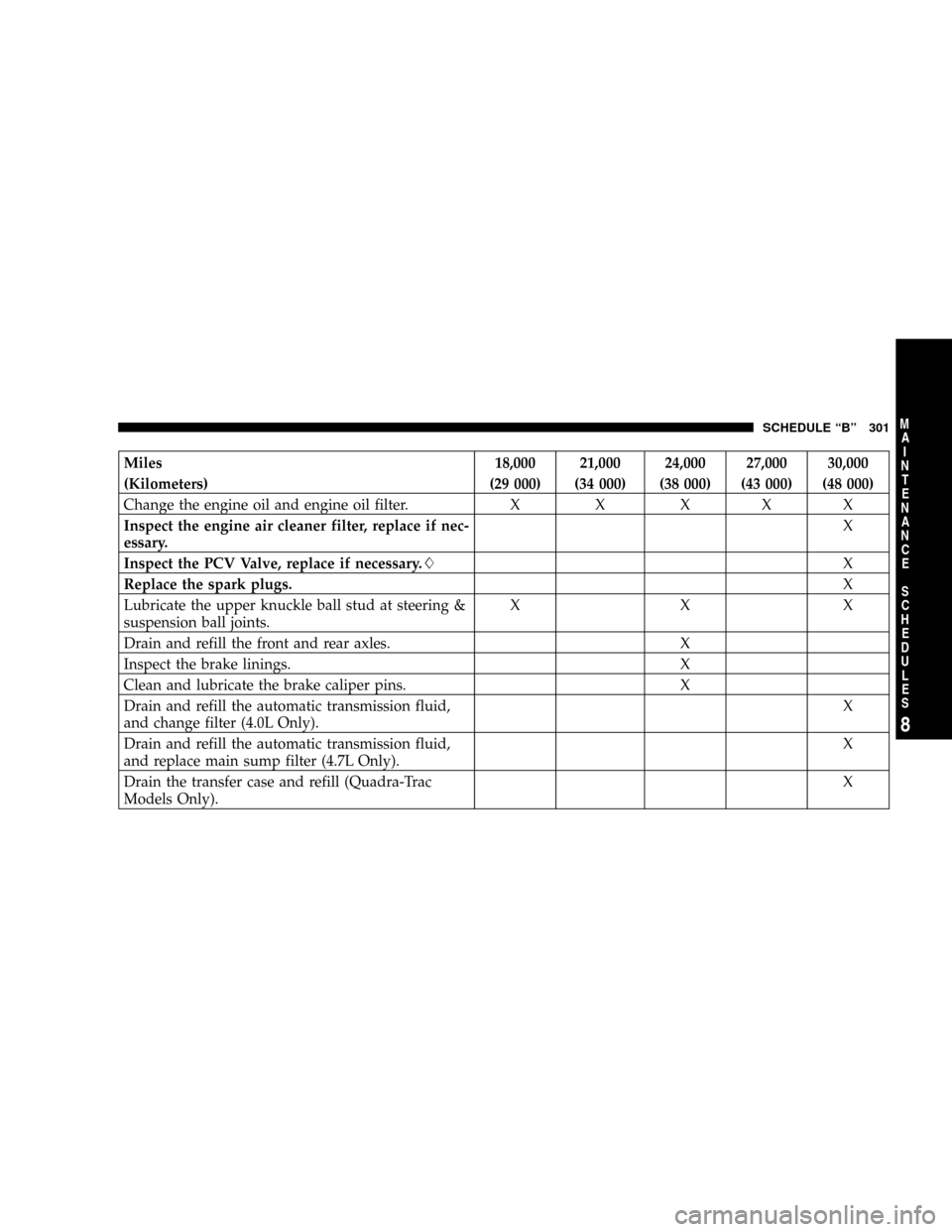
Miles 18,000 21,000 24,000 27,000 30,000
(Kilometers) (29 000) (34 000) (38 000) (43 000) (48 000)
Change the engine oil and engine oil filter. X X X X X
Inspect the engine air cleaner filter, replace if nec-
essary.X
Inspect the PCV Valve, replace if necessary.LX
Replace the spark plugs.X
Lubricate the upper knuckle ball stud at steering &
suspension ball joints.XXX
Drain and refill the front and rear axles. X
Inspect the brake linings. X
Clean and lubricate the brake caliper pins. X
Drain and refill the automatic transmission fluid,
and change filter (4.0L Only).X
Drain and refill the automatic transmission fluid,
and replace main sump filter (4.7L Only).X
Drain the transfer case and refill (Quadra-Trac
Models Only).X
SCHEDULE ªBº 301
8
M
A
I
N
T
E
N
A
N
C
E
S
C
H
E
D
U
L
E
S
Page 302 of 344

Miles 33,000 36,000 39,000 42,000 45,000
(Kilometers) (53 000) (58 000) (62 000) (67 000) (72 000)
Change the engine oil and engine oil filter. X X X X X
Inspect the engine air cleaner filter, replace if nec-
essary.X
Drain and refill the front and rear axles. X
Inspect the brake linings. X
Lubricate the upper knuckle ball stud at steering &
suspension ball joints.XX
Clean and lubricate the brake caliper pins. X
Inspect and replace drive belt, if necessary (4.0L
Only).X
302 SCHEDULE ªBº
8
M
A
I
N
T
E
N
A
N
C
E
S
C
H
E
D
U
L
E
S
Page 304 of 344
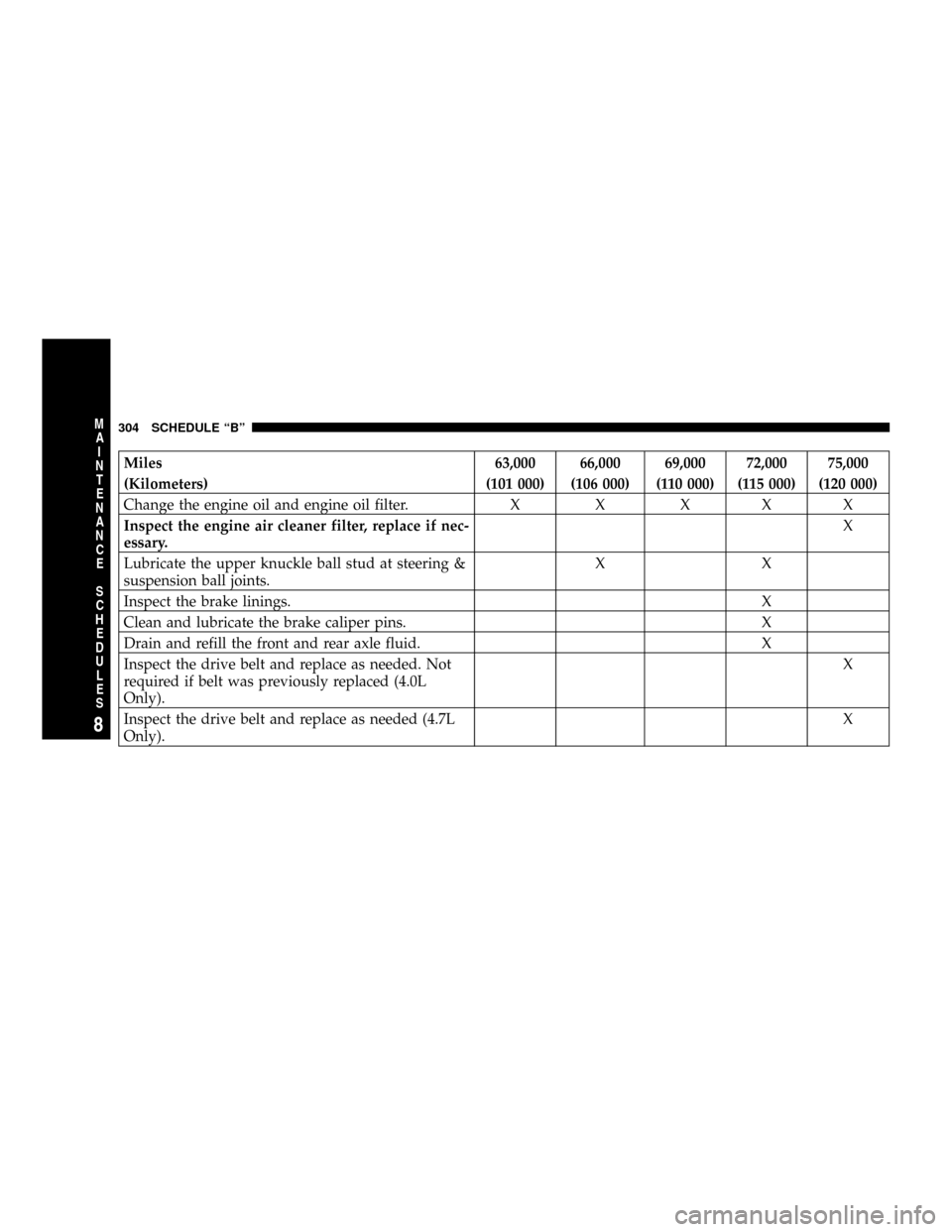
Miles 63,000 66,000 69,000 72,000 75,000
(Kilometers) (101 000) (106 000) (110 000) (115 000) (120 000)
Change the engine oil and engine oil filter. X X X X X
Inspect the engine air cleaner filter, replace if nec-
essary.X
Lubricate the upper knuckle ball stud at steering &
suspension ball joints.XX
Inspect the brake linings. X
Clean and lubricate the brake caliper pins. X
Drain and refill the front and rear axle fluid. X
Inspect the drive belt and replace as needed. Not
required if belt was previously replaced (4.0L
Only).X
Inspect the drive belt and replace as needed (4.7L
Only).X
304 SCHEDULE ªBº
8
M
A
I
N
T
E
N
A
N
C
E
S
C
H
E
D
U
L
E
S
Page 305 of 344
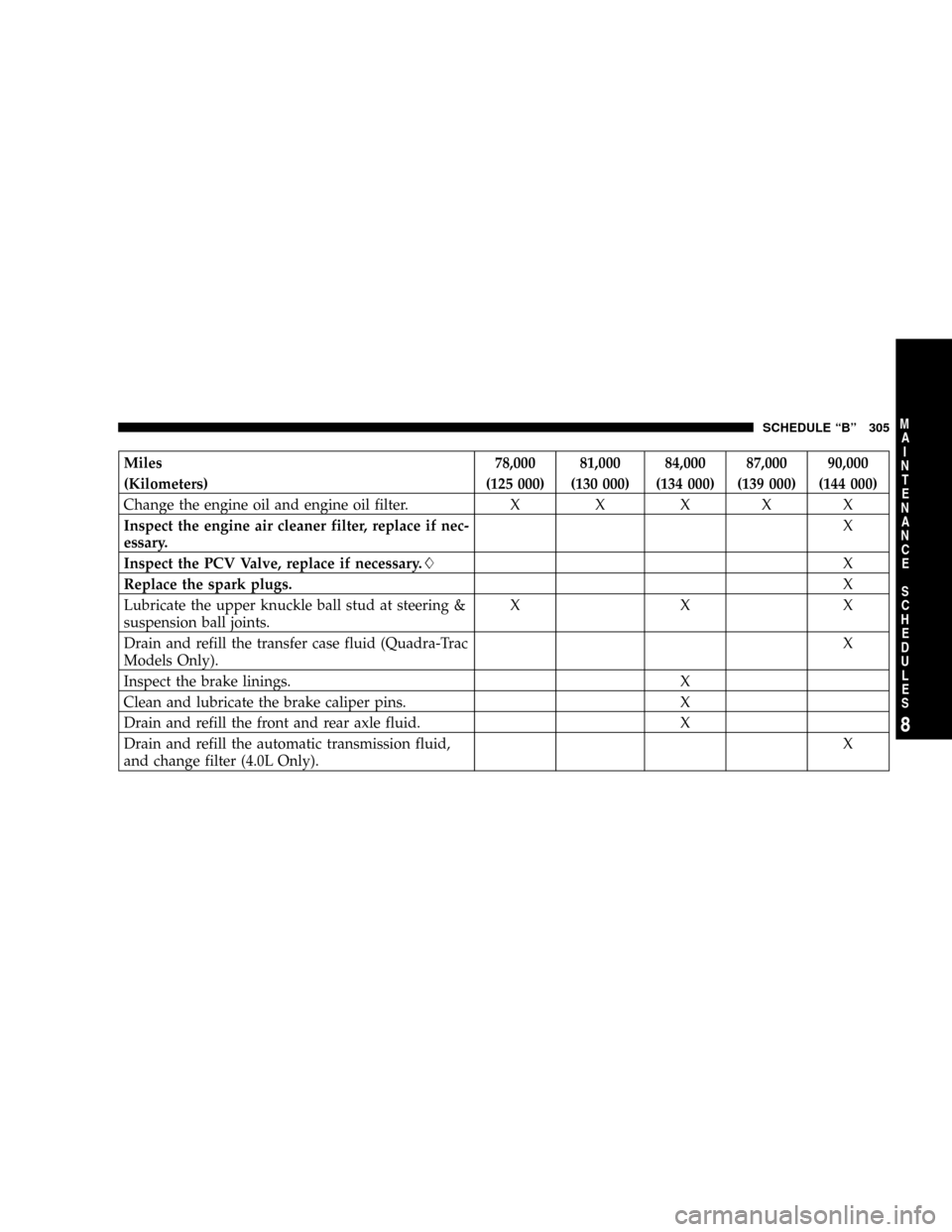
Miles 78,000 81,000 84,000 87,000 90,000
(Kilometers) (125 000) (130 000) (134 000) (139 000) (144 000)
Change the engine oil and engine oil filter. X X X X X
Inspect the engine air cleaner filter, replace if nec-
essary.X
Inspect the PCV Valve, replace if necessary.LX
Replace the spark plugs.X
Lubricate the upper knuckle ball stud at steering &
suspension ball joints.XXX
Drain and refill the transfer case fluid (Quadra-Trac
Models Only).X
Inspect the brake linings. X
Clean and lubricate the brake caliper pins. X
Drain and refill the front and rear axle fluid. X
Drain and refill the automatic transmission fluid,
and change filter (4.0L Only).X
SCHEDULE ªBº 305
8
M
A
I
N
T
E
N
A
N
C
E
S
C
H
E
D
U
L
E
S